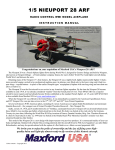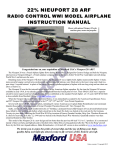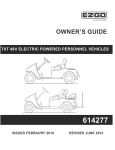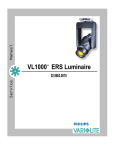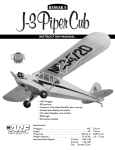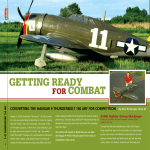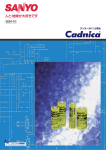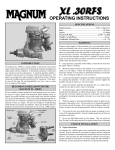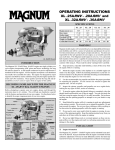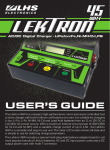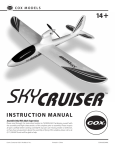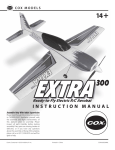Download WattAge Mirage 2000-5 Instruction manual
Transcript
o) Mirage 2000-5 Electric Powered Radio Control Flying Model Assembly Manual The Mirage 2000-5 is the latest interceptor jet in a long line of Mirage designs that find their beginnings back in the 1950’s. Speed, maneuverability, and payload capacity put it in a class with the infamous F-16 and F-18. A delta wing panform and sleek lines make it one fast and agile jet. Our model of the venerable Mirage is no different. This model adaptation has great slow speed characteristics yet at full throttle, the 400 size electric motor powers this Mirage at amazing speeds. The assembly is very simple which means you will be in the air in no time. 400 size electric aircraft are affordable and fly great yet are very economical to own and operate. We know you’ll enjoy flying this fast and agile semi-scale pusher jet. Just remember, this plane is quick and not suitable for inexperienced pilots. Thank you for choosing the Mirage 2000-5 for your next project. Items Needed (Not included in kit) o) 3 Channel Radio (with mixing or use the Wattage Electronic Mixer) Hitec Focus 3FM/Micro receiver shown. o) Micro Servos (CS 10 or 20’s) o) Speed control for 380 motors with BEC and Auto cut-off. Some speed controls require additional plugs o) 6x2, 6x3 or 6x4 propeller (APC or Graupner) o) Flat 7 or 8 cell 500A or 600AE Nicad battery pack o) Appropriate battery charger for the flight battery. The Promax Activator is an AC/DC input, versatile charger. 1 This instruction manual is designed to help you build a straight, great flying airplane. Please read this manual thoroughly before beginning assembly of your new Mirage 2000-5. Use the parts listing below to identify and separate all of the parts before beginning assembly. ÄKIT CONTENTSÃ We have organized the parts as they come out of the box for better identification during assembly. We recommend that you regroup the parts in the same manner. This will ensure you have all of the parts required before you begin assembly and will also help you familiarize yourself with each part. Optional Items Supplies Needed Note: Mirage is mostly made of foam. Therefore, most chemicals will destroy your plane. Only use recommended chemicals, glues, and paints, and only use them as described in the directions. Note: The parts need paint only for appearance. o) Pactra R/C Car Paint Back (for rear jet cone) o)Pactra R/C Car Paint White (for lower fuselage cover and nose cone) Note: The paint recommended is intended for the plastic vacuum formed parts ONLY. Do NOT use this paint on the foam or any part of the fuselage, wing, vertical, etc. 10) Ruler 11) Crescent Wrench or 8mm nut driver (same as most glow plug wrenches) 12) KNS Soldering Iron and 13) Solder 14) Pen 15) Pliers Optional: Magnum Z-Bend Pliers (not shown) 1) Excell Hobby Knife 2) 3M Masking Tape 3) Kwik Bond 5 Minute Epoxy, Mixing Sticks and Cups. 4) Paper Towels 5) Scissors 6) #0 Phillips Screwdriver 7) #1 Phillips Screwdriver 8) 1.5mm Hex Wrench 9) Needle Nose Pliers METRIC CONVERSION CHART Convert inches into millimeters: Inches x 25.4 = MM 1/64” = .4mm 1” = 25.4mm 1/32” = .8mm 2” = 50.8mm 1/16” = 1.6mm 3” = 76.2mm 3/32” = 2.4mm 6” = 152.4mm 1/8” = 3.2mm 12” = 304.8mm 5/32” = 4.0mm 18” = 457.2mm 3/16” = 4.8mm 21” = 533.4mm 1/4” = 6.4mm 24” = 609.6mm 3/8” = 9.5mm 30” = 762.0mm 1/2” = 12.7mm 36” = 914.4mm 5/8” = 15.9mm 3/4” = 19.0mm Optional Paint 13) 4) 12) 3) 1) 8) 9) 15) 14) 7) 5) 2) 11) 6) 10) Global guarantees this kit to be free from defects in both material and workmanship, at the date of purchase. This does not cover any components parts damaged by use, misuse or modification. In no case shall Global's liability exceed the original cost of the purchased kit. In that Global has no control over the final assembly or material used for final assembly, no liability shall be assumed for any damage resulting from the use by the user of the final user-assembled product. By the act of using the final user-assembled product, the user accepts all resulting liability. To make your modeling experience totally enjoyable, we recommend that you get experienced, knowledgable help with assembly and during your first flights. Your local hobby shop has information about flying clubs in your area whose membership includes qualified instructors. You can also contact the AMA at the address below. Academy of Model Aeronautics 5151 East Memorial Drive Muncie, IN. 47302-9252 (800) 435-9262 www.modelaircraft.org 2 If you should find a part missing or have questions about assembly, please call or write to the address below: Customer Service Center 18480 Bandilier Circle Fountain Valley, CA. 92728 Phone: (714) 963-0329 Fax: (714) 964-6236 E-Mail: [email protected] ÄSUGGESTIONÃ To avoid scratching your new airplane, do not unwrap the pieces until they are needed for assembly. Cover your workbench with an old towel or brown paper, both to protect the aircraft and to protect the table. Keep a couple of jars or bowls handy to hold the small parts after you open the bags. ÄNOTEÃ Please trial fit all the parts. Make sure you have the correct parts and that they fit and are aligned properly before gluing! This will assure proper assembly. Since the Mirage is, in part, hand made, every airplane is unique and minor adjustments may have to be made. However, you should find the fit superior and assembly simple. Photo 1 o) Fuselage o) Right Wing Half o) Left Wing Half o) Vertical Stabilizer Kit Contents Photo 1 Fuselage Left Wing Photo 2 o) Sticker Sheet o) Vacuum Form o) Molded Parts (canopy, etc.) Right Wing Photo 3 A) Plug Set B) Motor with leads and capacitors C) Wood Motor Mount Plate Vertical Stabilizer Sticker Sheet D) 3mm Washers (2) E) 3mm Motor Mounting Screws (2) F) Prop adaptor G) Prop Nut H) Prop Washer (2) I) Threaded Rod (2) J) Nylon Clevis (2) K) Control Horn Assembly (2) L) Wood Screw Plates (6) M) Wood Screws (6) K) Two Sided Mounting Tape. Photo 2 Photo 3 D) F) B) C) G) H) E) K) I) J) J) I) K) A) Vacuum Fo rmed Plastic Modled Parts Sheet L) M) K) Wattage guarantees this kit to be free from defects in both material and workmanship, at the date of purchase. This does not cover any components/parts damaged by use, misuse or modification. In no case shall Wattage's liability exceed the original cost of the purchased kit. In that Wattage has no control over the final assembly or material used for final assembly, no liability shall be assumed for any damage resulting from the use by the user of the final user-assembled product. By the act of using the final user-assembled product, the user accepts all resulting liability. 3 o)6. Spray motor cleaner into the opening on the side of the motor. The cleaning solution should be dark in color as it runs out of the motor. Continue spraying cleaner into the motor in short 1-2 second bursts, 5-6 seconds apart until the fluid runs clear. o)7. Apply 2 small drops of oil to each bushing. o)8. Continue running the motor until the battery dies or 15 minutes, whichever comes first. o)9. Oil the bushings again. Do not use too much and wipe away all excess oil. o)10. Remove the motor from the plane and repeat these steps every 30 to 40 flights. This will extend brush life, bushing life, and motor power output. Motor Break-In and Radio Prep For better motor life, follow this section on motor break-in and maintenance. Even if you do not break in the motor, follow the steps concerning radio and motor set up. Items Needed: To break-in the motor, you will need lightweight oil such as TS Racing oil and motor cleaner such as Performance Plus III. Preparation: Please carefully read the manufacturer’s radio operation directions, the charger directions, and the speed control (ESC) directions before attempting to connect power to any of the electronics. Performance Plus III Motor Cleaner TS Racing Motor Oil Apply Oil Here Mirage Motor Airframe Preparation Motor Rotation Optional: For better looks, locate two wood screw plates. Paint them white on one side only. Spray Here Cleaner o)1. Remove the internal foam wall between the cockpit area to the rest of the fuselage. This area will be for the battery pack. Special NOTE!: NEVER use these chemicals on the motor while it is in the plane. NEVER allow these chemicals to touch the plane in any way. They will DESTROY your plane beyond repair and this type of damage is not covered by warranty. Remove Foam From This Area o)1. Charge the flight battery and your radio’s transmitter battery. o)2. Connect the motor to the speed control (ESC) and the ESC to the receiver. Do NOT connect the propeller or adaptor. o)3. Connect the radio system and turn on the transmitter, then the receiver. o)4. Push the throttle stick to 1/3 throttle. The motor should begin turning in the clockwise direction (if you are facing the motor’s mounting surface.) If it turns in the wrong direction, Reverse the MOTOR wires where they connect to the ESC. Do NOT reverse the polarity of the battery! o)5. Apply a small drop of lightweight oil to the small bushings supporting the motor shaft. Cocpit Area o)2. Attach the four screw plates (unfinshed) to the bottom of the fuselage and the two located on each side of the cockpit with a small amount of Epoxy. The foam is recessed for the screw plates. 4 o)2. Trial fit one wing half to the side of the fuselage. Notice the flat surface of the wing matches the fuselage side. Align the wing with the molded wingfoil shape. If the wing shape does not match the fuselage, try the other wing half. When properly aligned, the wing halves cannot be interchanged. Notice the wing halves will not be twisted if you simply follow the shape of the wing on the fuselage side and use the mold lines in the side of the fuselage. Note: The proper dihedral angle should be zero. The top of the wing should be flat. From the factory, however, the correct angle should be cut into the wing and fuselage mating surfaces. Install Plates (4) o)3. Trim the plastic parts. Follow the scribe lines. (Use drawings) Cut small (1/4 inch) hole for battery cooling. Trim Shaded Area of Canopy Trim “brim” of the nose cone. Trial fit on the fuselage. Match the wing shape with the fuselage shape. o)4. If you intend to paint the plastic parts, paint them now. If you are using the recommended Pactra paint, paint them from the “inside.” Remember to wash and thoroughly dry the parts before painting. Paint the tail cone black. Paint the nose cone white. Paint the lower fuselage cover white. Leave all other parts clear. o)5. Set the parts aside for now. Align the leading edge and trailing edge with the mold line in the fuselage side Wing Assembly o)3. Mix a portion of 5 minute epoxy to attach the wing half. Only attempt to glue one wing half to the fuselage at a time. Apply a thin coat of epoxy to the wing and fuselage surface to be joined. Hold the wing in place until the glue is dry. o)1. Cut out the edges of the elevons on each wing half. Follow the cutting guides on the bottom surface of the wing. Use a ruler to achieve a straight cut. NOTE: The hinge line simply flexes. Do NOT cut the hinge line. Motor Installation o)1. Mount the motor to the firewall with the machine screws and washers. Trial fit the motor and firewall in the fuselage. The motor wires are routed through a factory made hole in the fuselage. Also notice the cutout area of the firewall faces down. o)2. The motor is level with the mold line on the side of the fuselage. The mold line is the fuselage centerline. Hinge Line (Do NOT cut) Cut Out Elevon Edges 5 Bottom View Note: Not all parts shown need to be installed in this step. Use this drawing as guide to better understand the assembly order. Control Horn Retaining Plate Wood Firewall (motor mount) Plastic Exhaust Cone Elevon 1.5mm Hex Wrench Set Screw provided. The head of the servo should be forward and the mounting lugs for the servo should be past the fuselage side Motor Screws and Washers Bottom View Adaptor Washer Propeller Washer Nut o)3. Compared to the centerline, the motor shaft should be angled up 2 degrees. Control Horns Angle motor shaft up about 2 degress from the fuselage centerline. Use mold line on the fuselage side as a guide. Servo Heads o)3. Thread the clevis onto the threaded rod until it just pokes through. This will ensure plenty of adjustment room. o)4. Install arms on the servo. o)5. Center the servo with your radio. o)6. For level flight, the elevon will be positioned “up” approximately 3/32 inch from neutral. o)7. Bend the rod as shown. Use the hole in the servo arm 7/16" from the servo center. o)4. Epoxy the firewall in position with epoxy glue. Use tape to hold the firewall in place while the glue dries. Double check the thrust angle before the glue dries. Radio Installation o)1. The control horns are positioned below the wing in the recessed area of the elevon. To mount the horn, use the keeper as a cutting guide to cut a small slit in the elevon. The horn slides through the elevon. A small snap keeper retains the horn. Look closely at the keeper. One side is beveled and one side is smooth. Slide the keeper onto the horn beveled side first. o)2. Mount the servo with the two sided tape Horn Clevis Threaded Rod The bend in the pushrod may only be necessary if you have placed the servo in toward the middle of the fuselage. 6 Make Z-Bend o)8. Temporarily install the motor to the speed control. Hook up the battery and the radio sys- tem to run the motor. Looking at the motor, the shaft should turn clockwise. If it does not turn clockwise, reverse the motor polarity. o)9. To reduce the chance of failure as well as reducing the voltage loss from plugs, we recommend direct soldering the motor wires to the speed control. However, if you need to use plugs, Tamiya style plugs have been included in the kit for your convenience. o)10. Position the receiver and speed control as shown. The speed control can be positioned rearward if needed to prevent radio interference. However, positioning the radio as shown should help balance the aircraft without the need for adding weight. Draw a centerline. Use the mold marks as a guide o)4. Once satisfied with the fit, use epoxy to glue the stabilizer to the fuselage (The same way described for the wing.) 90 degrees Receiver Reflex Tab Installation o)1. In order for your Mirage to fly properly, the clear plastic reflex tabs must be installed. o)2. Trim the tabs as shown. Be sure to leave a small area (Approx 2mm) around the tab to act as a gluing surface. Antenna Wire Speed Control o)11. The plastic cover sets over the radio compartment. Make small guide holes and then install the cover with the 4 screws provided. Leave 2mm edge around the tabs Cover for radio compartment Match high point of the tab with the wing’s trailing edge. Install with 4 wood screws Cut Here Recessed area for launching grip area Remove Shaded Area Place tab here Vertical Stabilizer Installation o)1. The Vertical Stabilizer is mounted on top of the fuselage. Notice the flat area at the end of the fuselage. o)2. To align the stabilizer, draw a centerline 6 7/8" on the fuselage top. Use the foam mold marks as a guide. o)3. Test fit the stabilizer. It should be perpendicular to the wing (90 degrees). Lightly sand the stabilizer mounting-surface if it does not align properly. o)3. Test fit the tabs. The tall side should be aligned with the wing’s trailing edge. o) 4. Install with epoxy just outside of the elevons. 7 Note: For best results, you should balance the propeller. We recommend a propeller normally made for a "tractor" airplane (engine in front). Make sure the front of the propeller faces forward. (Looking at the motor from the rear of the plane, the engine will turn clockwise.) o) 4. Apply tape to the battery as shown. This will make it easier to remove the battery. Finishing Details o)1. Use the photo and numbering system to help position the colored trim. Use a long straight edge or ruler to achieve straight edges on the decals when you cut them out. o)2. After the decals are applied, install the nose cone. Cut the cone from the plastic sheet. Then test fit the nose cone. Apply Tape Here Left Rudder 6-2 Right Rudder 6-1 Right Fuselage 2-1 Left Fuselage 2-2 Top of Fuselage 4 (behind canopy) Left Leading Edge 1-2 Right Leading Edge 1-1 Nose 5 White Canopy Stripe 8 o) 5. Remove the canopy. Install the battery into the cockpit area. o) 6. Access the battery plugs through the opening on the fuselage bottom. Push the connectors into the fuselage once connected. Red Scoop Strip Left Fuselage 3-2 Right Fuselage 3-1 Intake Ring Left 7-2 Right 7-1 o)3. Install the nose cone with epoxy glue. o)4. Find the exhaust cone. Trim the edges and open the screw holes. Do not oversize the openings. o)5. Remove the motor screws and install the cone with the motor screws. See Drawing on Page 6. o) 6. Install the canopy with the small screws provided (in the same manner as the lower radio cover.) Balance o) 1. For proper flight, the Mirage must be balanced. The balance point is 130mm to 150mm back from the leading edge at the fuselage side. o) 2. Move the battery or radio to achieve the proper balance. Balance Point 130 to 150mm behind the wing’s leading edge at the fusealge side. 130mm will create a more stable jet at slow speeds Propeller and Battery Installation 150mm will create a faster jet but with a higher stall speed. o) 1. Find the propeller adapter. o) 2. Install the adapter with the 3mm set screw (you will need a 1.5mm hex wrench.) Leave 1/ 8 inch space between the adapter and the plastic cone. o) 3. Install the propeller with the nut provided. 8 Radio Set-up and Control Throws Position elevator trim in the neutral position. Then adjust the linkage to bring the elevon up 1-2 mm Trimming for Best Performance o ) 1. Neutral elevon is 2 mm up at the inner edge. Fine tuning the balance point (CG) and elevon neutral point will result in better, more predictable flight characteristics. To trim the Mirage, bring the plane into level flight from a shallow dive. Elevon is up 1-2 mm for level flight. During the level flight portion, watch the plane. If it climbs, try reducing the amount of “up” elevon. If you have little or no “up” elevon, try moving the battery back 1/4 inch. o) 2. Right stick should make the right elevon move up and the left elevon move down. o) 3. Forward stick should make both elevons move down. o) 4. If the controls do not work in the proper direction, check your radio's servo reversing. o) 5. For your first flight, set the control throws to approximately 5/16 inches up and 5/16 inches down. Once you have become familiar with the plane, you may increase the throws to as much as 9/16 inches. If you have a computer radio, increase the aileron travel first. The elevator will be sensitive enough at 5/16 inches for most manuevers. If the Mirage dives, increase the amount of “up” elevon. If you have more than 2mm up elevon, move the battery pack forward 1/4 inch. This procedure will decrease drag and keep the pitch sensitivity “in the envelope.” If it climbs, reduce the up elevon Launching If it dives, increase the up elevon Throw the Mirage with the wings level (from right to left.) The fuselage should be level to the ground. The model should be thrown with the motor off. Immediately after launch, apply power and maintain level flight for 40-60 feet to build up airspeed. Launching with the motor off will help prevent the propeller from striking your hand causing serious injury. Choosing to Fly and Pre-Flight Check Do not fly near powerlines, obstacles, or around people. The Mirage is not a toy and can cause harm or injury. Do not fly if it is windy. Pick a calm day for your first flights. Attach a 8 inch long, by 1 inch wide piece of ribbon to your antenna with string. If the wind blows it out more than 45 degrees from the antenna, the wind is blowing too hard. Always launch into the wing and do not fly in high winds. For your first flights, fly the Mirage in calm weather to prevent accidents until you become familiar with the model. Properly charge your transmitter and flight batteries. Weak batteries cause crashes. Hold Plane Level ok Double check control movement direction and throws. Range test the radio before your first flight. Perform power-on range tests before your first flight. 9 Motor Maintenance Battery Use For longer motor life and better performance, regular cleaning is necessary. Follow these steps for regular maintenance. 1. Remove the propeller and propeller assembly. Then remove the motor from the airplane. Leave the motor leads attached to the speed control. 2. Cover the tail of the fuselage with plastic wrap to prevent solvents from touching the foam. NOTE: Foam will melt and be destroyed by motor cleaners and some oils. Take great caution when using these products. 3. Spray cleaner onto the motor commutator until the cleaner runs clear. This is best done outdoors with good ventilation. 4. Place a small drop of oil on each end of the motor shaft. 5. Run the motor at 1/3 throttle. Spray a little more cleaner onto the motor. 6. Turn off the motor and re-oil the bushings at each end of the shaft. 7. Install the motor back in the plane and install the prop. It’s that simple. This process keeps the motor bushings lubricated and the commutator clean. Complete this task every 30 to 40 flights for best performance. Good battery usage and maintenance is crucial for the great performance you expect from your new Mirage. Much has been written about Nickel Cadmium battery care and maintenance. Indeed you can find much information in magazines and on the internet. While small details can make slight differences in battery performance, here are a few tips that most will agree help batteries sustain their best performance. 1. Use a peak detector (or Delta Peak) charger. This type of charger is the only way to ensure your battery is properly charged each flight and does not overcharge the battery. 2. Choose a charger that is designed for your exact battery size or has adjustable output current. The small batteries most commonly used in 400 size planes need to be charged at no more than 2 time their rated amperage. Therefore, a Sanyo 600AE battery should not be charged at more than 1200 mah (or 1.2 amps). While some charge at a higher rate, staying below the “twice factor” will ensure long life. 3. Let the batteries cool before charging. After a flight, the battery becomes very warm and sometimes very hot. NEVER charge a hot battery. If you first let it cool, it will take more charge and give better performance. 4. Discharge the battery to 1.05 volts per cell. (example: for a 7 cell battery, that would be :7.35 volts.) Every use or at least very regularly, discharge the battery to this level. Let the battery cool, and then charge the battery. Some discharge their batteries to a lower voltage. However, discharging the battery below this point can lead to cell damage, especially in cells that are not “matched”. Deans and Astro Flight make discharges that will discharge the battery and automatically shut off at a safe voltage. 5. After each flight, touch the battery. If it is excessively hot after the flight, examine the motor. It may have a bad component. A malfunctioning motor can draw 2-5 times normal current. Keep track of your motor. Date cleaned: 10 ODUCT EV ALU ATION SHEET RODUCT EVA UA PR Telling us what you like and don't like determines what model kits we make and how we make them. We would appreciate it if you would take a few minutes of your time to answer the following questions about this kit. Simply fold this form on the dotted lines, seal with tape and mail it to us. Do not use staples and make sure our address faces out. 1) Kit: 7) Was any of the assembly difficult for you? If yes, please explain. q Yes q No _____________________________________ _____________________________________ _____________________________________ _____________________________________ Wattage Mirage 2000-5 2) Where did you learn about this kit? q Magazine Ads q Friend q Hobby Shop q Other q Internet 3) What influenced you the most to buy this kit? q Magazine Ads q Price q Type of Model q Box Art q Recommendation q Other q Internet 8) What did you like most about this kit? q Assembly Manual q Parts Fit q Hardware Supplied q Price q Other _____________________________________ _____________________________________ _____________________________________ 4) Did you have any trouble understanding the written instructions? If yes, please explain. q Yes q No _____________________________________ _____________________________________ _____________________________________ _____________________________________ 9) What did you like least about this kit? q Assembly Manual q Parts Fit q Hardware Supplied q Price q Other _____________________________________ _____________________________________ _____________________________________ 5) Did you have any trouble understanding any of the photographs. If yes, please explain. q Yes q No _____________________________________ _____________________________________ _____________________________________ _____________________________________ 10) Are you satisfied with the finished model? If no, please explain. q Yes q No _____________________________________ _____________________________________ _____________________________________ _____________________________________ 6) Were any of the kit parts: q Damaged q Wrong Size q Missing q Wrong Shape If you checked any of the boxes above, did you contact our Customer Service Department to re solve the problem? q Yes q No 11) How does this kit compare to similar kits by other manufacturers? q Better Than q As Good q Not as Good Additional Comments: _________________________________________________________________ _____________________________________________________________________________________________ _____________________________________________________________________________________ _____________________________________________________________________________________ _____________________________________________________________________________________ 11 Fold along dotted line Post Office will not deliver without proper postage Complete Return Address Information Here Watt Age Attn: Customer Service Department 18480 Bandilier Circle Fountain Valley, CA. 92728 Fold along dotted line 12













